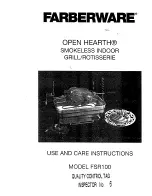
41
9.1 - Condensate
disposal
WARNING!!!
The
condensate trap is the same
condensate neutralizer box
(see Figure 9-1, item “B”).
Condensate neutralizer box
MUST be filled of water or
combustion gases will enter
the room. This can result in
excessive levels of carbon
monoxide which can cause
severe personal injury or
death!
WARNING!!!
The
condensate neutralizer box
(see Figure 9-1, item “B”)
must be kept within the unit,
as shown in Figures 3-3
through 3-6. Removing the
condensate neutralizer box
from its position may result
in combustion gases entering
the room.
This can result in
excessive levels of carbon
monoxide which can cause
severe personal injury or
death!
This heater produces water as a
byproduct of combustion. The heater
is equipped with a condensate
neutralizer box, Figure 9-1, item “B”,
for the evacuation of condensate and
to prevent the leakage of combustion
products. The condensate drains
through pipe shown in Figure 9-1 item
“C” and Figure 9-2 item “A”.
Slope condensate tubing down
and away from the heater into a
drain or drain pan (See Figure 9-2).
Condensate from the heater will be
slightly acidic (around pH 4). The
neutralizing box (see figure 9-1, item
“B”) will neutralize the condensate
products.
CAUTION!!!
The condensate
discharge line must be of
materials approved by the
authority having jurisdiction. In
the absence of other authority,
PVC and CPVC pipe must
comply with ASTM D1785 or
D2845. Cement and primer
must comply with ASME D2564
or F493. For Canada use CSA
or ULC certified PVC or CPVC
pipe, fittings, and cement.
be carried out with a pipe with
an internal diameter equal to or
greater than
3/4 in
(
19 mm)
;
be installed in such a way so as to
avoid the freezing of the liquid;
never discharge into gutters or rain
collectors;
be properly pitched towards the
point of discharge avoiding high
points, which could place the
condensate system under pressure.
CAUTION!!!
The condensate
drainage system is designed
to empty all the condensate
produced by one heater
only. Each heater must
be equipped with its own
condensate drainage system
or the drainage system may
malfunction.
A condensate removal pump is
required if the heater is below the
drain. When installing a condensate
pump, select one approved for
use with condensing heaters and
furnaces. The pump should have an
overflow switch to prevent property
damage from condensate spillage.
COMMONWEALTH OF
MASSACHUSETTS SPECIAL
REQUIREMENT
This heater meet the special
requirement of the Commonwealth
of Massachusetts, because the
neutralization unit is already
installed within the heater.
9 - INSTALLATION - Condensate disposal
Summary of Contents for Esteem 399
Page 3: ...3 SAFETY INSTRUCTIONS ...
Page 5: ...5 SAFETY INSTRUCTIONS ...
Page 112: ...112 17 MAINTENANCE ...
Page 116: ...116 19 SPARE PARTS Spare parts ...
Page 135: ......
















































